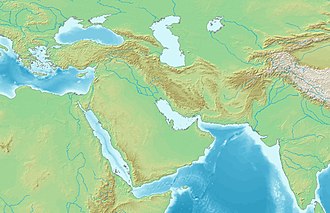Asir Mountains
Mountain range in Saudi Arabia From Wikipedia, the free encyclopedia
The Asir Mountains[1] (Arabic: جِبَال عَسِيْر, jibāl ʿasīr; Arabic pronunciation: [d͡ʒɪbaːl ʕasiːr] ('Difficult')) is a mountainous region in southwestern Saudi Arabia running parallel to the Red Sea. It comprises areas in the Region of 'Asir, but generally, it also includes areas near the border with Yemen. The mountains cover approximately 100,000 square kilometres (40,000 sq mi) and consists of mountains, plains, and valleys of the Arabian highlands.[2] Sensu lato, they are part of the Sarawat Mountains,[3] defining the latter as the mountain range which runs parallel to the Tihamah throughout the western portion of the Arabian Peninsula, particularly the western parts of Saudi Arabia and Yemen.[4][5][6]
| Asir Mountains | |
|---|---|
 A rocky mountain in the range | |
| Naming | |
| Native name | جِبَال عَسِيْر (Arabic) |
| Geography | |
| Country | Saudi Arabia |
| Region | Arabian Peninsula |
| Range coordinates | 21.6°N 39.8°E |
Geology
The mountains consist primarily of sedimentary rock, limestone, sandstone and shale, of Jurassic, Cretaceous and Paleogene origin on a Precambrian granitic basement.[2]
Climate and agriculture
The region has the highest average rainfall of Saudi Arabia[citation needed] due to largely seasonal rain. Average rainfall can range from 600 millimetres (24 in) to over 1,000 millimetres (39 in) per year, in wet regions. The eastern plains and plateaus receive much lower amounts, from 500 millimetres (20 in) to below 100 millimetres (3.9 in) per year.[2]
The region's crops, most of which are cultivated on steeply terraced mountainsides, include wheat, coffee, cotton, indigo, ginger, vegetables, and palms. The region also supports cattle, sheep, goats, and camels.[citation needed]
Biodiversity
The region's difficult terrain has helped preserve the region's unique biodiversity. Several new Myxomycetes fungi species have been discovered in the region, as have a variety of previously undiscovered plants.[7] Asir is also thought to be one of the last natural habitats of the Arabian leopard.[2][5][6] and also the Asir magpie, believed to be down to its last 135 pairs.[8]
Gallery
- Jabal Sawdah ("Mount Sawdah")
- Habalah Valley near Abha
- Jabal Atherb, as seen from Ḥawālah in Bareq
See also
References
Further reading
Wikiwand - on
Seamless Wikipedia browsing. On steroids.








